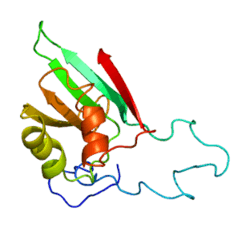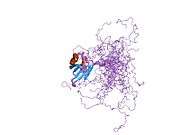Eukaryotic translation initiation factor 1 (eIF1) is a protein that in humans is encoded by the EIF1 gene.[3][4][5]
eIF1 interacts with the eukaryotic small (40S) ribosomal subunit and eIF3, and is a component of the 43S preinitiation complex (PIC).[6] eIF1 and eIF1A bind cooperatively to the 40S to stabilize an "open" conformation of the preinitiation complex (PIC) during eukaryotic translation initiation.[6] eIF1 binds to a region near the ribosomal A-site in the 40S subunit and functions in a manner similar to the structurally related bacterial counterpart IF1.[7]
References
- 1 2 3 GRCh38: Ensembl release 89: ENSG00000173812 - Ensembl, May 2017
- ↑ "Human PubMed Reference:".
- ↑ Fields C, Adams MD (Jan 1994). "Expressed sequence tags identify a human isolog of the suil translation initiation factor". Biochemical and Biophysical Research Communications. 198 (1): 288–91. doi:10.1006/bbrc.1994.1040. PMID 7904817.
- ↑ Sheikh MS, Fernandez-Salas E, Yu M, Hussain A, Dinman JD, Peltz SW, Huang Y, Fornace AJ (Jun 1999). "Cloning and characterization of a human genotoxic and endoplasmic reticulum stress-inducible cDNA that encodes translation initiation factor 1(eIF1(A121/SUI1))". The Journal of Biological Chemistry. 274 (23): 16487–93. doi:10.1074/jbc.274.23.16487. PMID 10347211.
- ↑ "Entrez Gene: EIF1 eukaryotic translation initiation factor 1".
- 1 2 Aitken CE, Lorsch JR (Jun 2012). "A mechanistic overview of translation initiation in eukaryotes". Nature Structural & Molecular Biology. 19 (6): 568–76. doi:10.1038/nsmb.2303. PMID 22664984.
- ↑ Fraser CS (July 2015). "Quantitative studies of mRNA recruitment to the eukaryotic ribosome". Biochimie. 114: 58–71. doi:10.1016/j.biochi.2015.02.017. PMC 4458453. PMID 25742741.
- ↑ "EIF1 - Eukaryotic translation initiation factor 1 - Homo sapiens (Human) - EIF1 gene & protein". www.uniprot.org. Retrieved 2018-09-23.
Further reading
- Lian Z, Pan J, Liu J, Zhang S, Zhu M, Arbuthnot P, Kew M, Feitelson MA (Mar 1999). "The translation initiation factor, hu-Sui1 may be a target of hepatitis B X antigen in hepatocarcinogenesis". Oncogene. 18 (9): 1677–87. doi:10.1038/sj.onc.1202470. PMID 10208429.
- Fletcher CM, Pestova TV, Hellen CU, Wagner G (May 1999). "Structure and interactions of the translation initiation factor eIF1". The EMBO Journal. 18 (9): 2631–7. doi:10.1093/emboj/18.9.2631. PMC 1171342. PMID 10228174.
- Chin LS, Singh SK, Wang Q, Murray SF (2000). "Identification of okadaic-acid-induced genes by mRNA differential display in glioma cells". Journal of Biomedical Science. 7 (2): 152–9. doi:10.1007/BF02256622. PMID 10754390.
- Mendell JT, Medghalchi SM, Lake RG, Noensie EN, Dietz HC (Dec 2000). "Novel Upf2p orthologues suggest a functional link between translation initiation and nonsense surveillance complexes". Molecular and Cellular Biology. 20 (23): 8944–57. doi:10.1128/MCB.20.23.8944-8957.2000. PMC 86549. PMID 11073994.
- Rush J, Moritz A, Lee KA, Guo A, Goss VL, Spek EJ, Zhang H, Zha XM, Polakiewicz RD, Comb MJ (Jan 2005). "Immunoaffinity profiling of tyrosine phosphorylation in cancer cells". Nature Biotechnology. 23 (1): 94–101. doi:10.1038/nbt1046. PMID 15592455.
External links
PDB gallery |
|---|
2if1: HUMAN TRANSLATION INITIATION FACTOR EIF1, NMR, 29 STRUCTURES |



